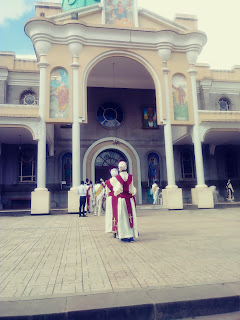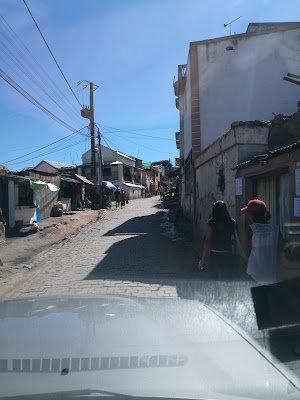Wycliffe appeared with his Mercedes sedan, silver color. Not bad. Wycliffe is a CPA and married to Diana, a Ugandan who is also a CPA.We drove for over an hour to arrive at our hotel, the Cassia Lodge. The hotel has about 20 rooms built like a motel but the site is absolutely stunning. At about 1000 meters above the level of Lake Victoria, the view from our balcony is spectacular as we look down on Murchison Bay. One can see rolling hills 50 or 80 miles away in the clear sunlight day. Murchison Bay is where part of the movie The African Queen was shot.
That evening all 3 kids showed up at the hotel. Wycliffe 35, Chris 32 and Fiona 29. We had drinks on the patio and then sat in the dining room and had a leisurely meal catching up on what each kid had been doing. I had not seen them in 10 years. All 3 have small kids so the next generation is well underway. Wycliffe is the head of internal audit at a large research facility in Kampala. Chris had just returned from a year abroad in Qatar as a security guard. He is now building up a sand supply business around Kampala. Fiona has her own shop in Kampala supplying dress making material.
They obviously do not get together very often so they were able to do their own catching up. It was nice to see that they all were getting on with their lives. Monique and I had to struggle at times as these East Africans have a strong accent when speaking English and one needs to tune one's ear to get their conversation. After lots of talking and chatting, the kids left for the evening.
 |
| Patio of Cassia Lodge |
 |
| Fiona |
 |
| Monique and Wycliffe. |
 |
| Chistopher and Fiona. |
 |
| Christopher |
 |
| The hotel garden from our room. |



Murchison Bay from our room.
The next morning Chris and Fiona showed up at the hotel in the car of Fiona's husband who is a pharmacist. Fiona was still suffering from some fever which happens so often to Africans, particularly in the rainy season. Here in Kampala, it seems to rain each morning but on both days we have been here, by 10 or 11 am the skies cleared and the sun came out. Of course, when it rains here, it pours deluges of water making roads impassable and even worse making them like ice patches as most are out of clay. The roads are literally terrible. What used to be tarred roads are now just a patchwork of ever greater potholes which are sometimes a foot deep. The result is that traffic crawls with cars weaving from left to right to try and avoid the larger holes. One could expect that with 50 and 60% unemployment there would be crews patching holes but that is not the case. They cannot even get themselves organized to have scrappers or bulldozers to even out huge bumps and holes in the unpaved roads. To add to the mayhem, there are about 10 times as many motorcycles as cars so one is constantly being passed, cutoff or followed by an endless stream of maniacs on bikes weaving in and out of cars and around the patchwork of holes, bumps and huge depressions in what passe for roads.
The only saving grace is that no one trusts the other driver to do the right thing and no one can speed under these conditions. As a result, traffic crawls but one rarely sees any accidents or even fender-benders. There are occasional traffic lights hanging from poles, but, of course, they do not work. But even if they do work, they are totally ignored and traffic just weaves into a slow stream with each side gliding ahead of the other. The pace of traffic means that to go 3 km, or a couple of miles, one needs an hour, or 2 or 3... To add to the confusion, Ugandans love the sound of their car horns so that there is a steady cacophony of horns going on all the time, and, of course, being totally ignored by everybody. Then there are corners or roundabouts where the confusion is even greater because some police person thinks it his or her duty to screw traffic up even more by waving wildly and being, for the most part, also ignored.
I had wanted to show Monique the beginning of the Nile river which is where Lake Victoria feeds into a narrow outlet which marks the start of the long trek of the Nile to the Mediterranean. This happens at Jinga which is some 90 km (55 miles) from our hotel. Even Google maps estimates that it takes 2.5 hours to get there which implies a very high average speed of about 20 miles per hour... An hour into the drive to Jinja, we had not even cleared the city of Kampala and were stuck in traffic which was only inching along. This would have meant that we would be on the road for at least 3 hours and then have to turn around and come back. I decided that we would not go to Jinja but instead visit the African Village artisan shops in downtown Kampala.
I was aghast to go by the Sheraton and Speke Hotels where I had stayed on previous visits, 25 years earlier only to find that the roads had not changed in those many years. What had changed was that the car and motorbike population had greatly increased and traffic was even worse. We finally made it to the village and spent an hour ambling from shop to shop looking for small souvenirs which would fit in our already rather full trunks. There were no other tourists in the place which had about 50 little shops so we were able to get a nice collection of small things with the usual bargaining, which is part of the fun of such places. We then headed back to the hotel which is on the southern side of the city. Fiona was feeling ill, so Chris took over the driving and we were back in the peace and quiet of our Cassia Lodge by 1 pm. This gave us the afternoon to read and write. I went for a nice swim in the hotel pool looking down on Lake Victoria.
Lake Victoria is the second largest lake in the world after Lake Superior in North America. It is about 200 miles long from North to south and up to 160 miles wide and is shared by Uganda, Kenya and Tanzania. It has some 3500 km of shoreline around the lake. 85% of the lake water is supplied by rainfall making the lake level highly sensitive to annual rain falling in the area. If fact, I was told that the lake is actually getting smaller each year due to evaporation as the lake is not very deep. The lake did actually dry up completely some 17,000 years ago. If that were to happen again, it would be a disaster for the three countries surrounding it but it would be fatal for Egypt which depends on the lake to keep the Nile flowing through the length of the country. There are some 3000 islands which are inhabited around the lake. Most of the local communities live off fishing on the lake.
The lake's ecosystem was in good shape due to existence of a type of fish called Haplochromis or Haps. This type of fish fed on all sorts of rotting material which fed the water and the fish. In 1954, the silly people of the the Food and Agricultural Organization (FAO) decided they would improve the nutrition of the 1000's of people living off the lake. They introduced two new types of fish, Nile Perch and Nile Tilapia. These fish had no predators and started feeding on the local fish, including the Haps. They proceeded to wipe out the Haps and grew to such large sizes that the local fishermen did not have the nets needed to land them. An ecological disaster continued until finally these Nile fish started to die off 10 years later.
But by that time, the delicate balance of the lake was upset and the lake started to have bad oxygen levels resulting in masses of algae and spreading water hyacinths. Today, the lake is still in bad shape but apparently some species of the Haps may be coming back and there is hope the lake will revive.
Below are pictures of Kampala and the 2 of us in the artisan village of Kampala which is worth a stop.
 |
| Streets of Kampala |
 |
| Monique and I in the artisan market |
 |
| Man doing his bathing in city drain. |
In the evening, Wycliffe came to the hotel to pick us up for a dinner at his house. It is a house we help finance 15 years ago and now serves as the family house of Wycliffe, his wife Dianna and their 2 boys Thomas and Elijia. Chris, the brother and his wife were there with their daughter Channel as well as the sister Fiona with her husband and 2 kids. They had the dinner catered and it was quite a spread including a huge cake with the inscription :"Monique and Alex, Africa tour 2018".
It was really an African dinner and it was wonderful to be in the middle of this group. The little kids were amazingly quiet during the whole meal. They certainly were not creating a huge amount of noise. We were told it was because we were new in the house and that they could be very noisy under normal conditions. We had time to catch up with each one and I must admit I was quite proud how they all turned out. Conversations were sometimes difficult due to the heavy accents of these East Africans, but things went smoothly during the whole evening. We left at around 10 pm and Wycliffe brought us back to our hotel in his wife's Range Rover. The roads were terrible so our dinner was well shaken by the time we got back to the hotel.
A big thank you to Dianna and Wycliffe for organizing the dinner and to Chris and Fiona for being there with us. We were honoured.
 |
| Fiona, Diana, Chris's wife, Chris, Wycliffe |
 |
| Wycliffe. Fiona, me, Diana, Chris with his wife and daughter. |
 |
| Monique and Alex with our African children and grandchildren. |
 |
| Fiona and husband, Diana, Chris's wife and daughter, Chris and Wycliffe. |

 |
| Diana's SUV. |
We are off this afternoon back to Addis to connect to the Paris flight for an early arrival in Paris tomorrow. We will overnight at a hotel on the airport in Paris and head back to Florida on Saturday.






























































